Trump prošao pokraj buduće nobelovke za mir kao pokraj turskog groblja
Page 8 of 12
Page 8 of 12 •  1, 2, 3 ... 7, 8, 9, 10, 11, 12
1, 2, 3 ... 7, 8, 9, 10, 11, 12 
 Re: Trump prošao pokraj buduće nobelovke za mir kao pokraj turskog groblja
Re: Trump prošao pokraj buduće nobelovke za mir kao pokraj turskog groblja
[size=47]Global warming causing ocean 'emergency' [/size]
It will be the clearest declaration yet on how an overheating world is hammering our oceans and frozen regions.
Scientists from the IPCC have been meeting in Monaco to finalise a report on the seas and the cryosphere.
a group of people in a large body of water
Full Screen
1/3 SLIDES :copyright: Getty Images
[/size]
Published tomorrow, it will outline how the oceans have been our best friend in coping with rising temperatures.
But it will warn that warming is turning the seas into a huge potential threat to humanity.
Researchers from the Intergovernmental Panel on Climate Change (IPCC) were encouraged by Prince Albert II and the Monaco government in 2015 to produce a special report on the oceans and cryosphere.
For the past three years, the scientists have been reviewing hundreds of published papers on how climate change affects the seas, the poles and glaciers.
Their report will track the flow of water from the frozen tops of mountains to the bottom of the seas, and how this is changing in a warmer world.
Over the past few days, they have been trying to agree a short summary of their findings with government representatives that will be published on Wednesday.
It will likely detail the growing threat from rising sea levels, that could imperil hundreds of millions of people before the end of this century.
It will also warn of the threat posed by the growing acidification of the seas, the threats to coral and fisheries and the possibility that warming might melt permafrost, releasing huge amounts of the CO2 gas that's the key to rising temperatures.
"At current emissions rates, we are effectively dumping one million tonnes of CO2 into the oceans every hour," said Melissa Wang, a scientist with Greenpeace.
"Unless we accelerate efforts to curb carbon emissions and take greater steps to protect our oceans, there will be devastating human, environmental and economic consequences."
Since 1970, the oceans have absorbed more than 90% of the extra heat that's come about through global warming. If they hadn't taken in that warming, the surface of the planet would have been devastated by excess heating.
All this absorption has come at a price though. Our seas are now warmer, less salty and more acidic as a result.
"The reality is that we have been quietly reliant on the ocean to do these things, but there comes a point where the ocean changes because of the scale of what we are doing," Prof Dan Laffoley, from the International Union to Conserve Nature (IUCN) told BBC News.
It will chart the rise of CO2 that is making the waters more acidic and more difficult for sea life. It will also link the warming to the rise of "superstorms".
One of the big changes has been in the impact of warming on the Greenland and Antarctic ice sheets, which has grown substantially in recent decades.
These frozen regions are critically important for global sea levels, which impact flooding around the world.
As documented by my colleague David Shukman, this year has been one of record melting on the gigantic frozen island of Greenland.
In one day alone it lost 12.5 billion tonnes of ice.
Antarctica has also enormous capacity to raise the waters around the world.
According to studies, the amount of ice lost from the vast frozen region increased six-fold per year between 1979-1990 and 2009-2017.
"By the end of this century, and if current adaptation efforts are not substantially scaled up, we must expect high levels of risk on low coasts such as atoll islands like the Maldives, and some Arctic communities even in a low-emission scenario," said Alexandre Magnan, a research fellow at the policy research institute IDDRI in Paris, and a co-author of the IPCC Ocean Report.
"In a higher-emission scenario, even wealthy megacities such as New York or Shanghai and large tropical agricultural deltas such as the Mekong will face high or very high risks."
The estimations for the centuries beyond 2100 will be even more stark, with suggestions that sea level rise could be 100 times higher than today.
"What happens with sea level rise is not disconnected with what happens with warming," said Jane Lubchenco, former administrator of the US National Oceanic and Atmospheric Administration (Noaa) and a co-chair of the expert group of a High Level Panel for a Sustainable Ocean Economy.
"Because the ocean is warming we are getting more intense storms, because the ocean is rising the impact of storm surge from those storms has much more potential."
"Extreme sea level events, such as surges from tropical cyclones, that are currently historically rare, for example today's hundred-year event, will become common by 2100 under all emissions scenarios," said Jean-Pierre Gattuso, an IPCC author and a CNRS Research Scientist at Sorbonne University.
"This will have with major consequences for many low-lying megacities and small islands."
However the report will also look at ocean acidification, and will show how climate change is changing the balance.
There will also be sections on coral reefs, and there will also be a focus on fishing and fish stock, which are likely to suffer dramatic declines.
A report last year stated that two thirds of these giant ice fields could disappear by the end of the century without rapid emissions cuts. This could have huge implications for the millions of people living in the region.
The IPCC report will also document the threat posed by warming to permafrost.
Some 30-99% of the Northern Hemisphere's permanently frozen soils could melt by the end of the century, freeing up billions of tonnes of CO2 which could in turn accelerate warming to a new, ever more dangerous level.
There is great scope for renewable energy systems based on the oceans while cutting carbon from shipping would be a major step forward. Planting more mangroves and sea grass could remove huge amounts of CO2 from the atmosphere.
Even the potential to switch diets to get more of our protein from the oceans would likely help cut carbon.
It will be the clearest declaration yet on how an overheating world is hammering our oceans and frozen regions.
Scientists from the IPCC have been meeting in Monaco to finalise a report on the seas and the cryosphere.
a group of people in a large body of water
Previous Slide
Next Slide
[size]Full Screen
1/3 SLIDES :copyright: Getty Images
[/size]
Published tomorrow, it will outline how the oceans have been our best friend in coping with rising temperatures.
But it will warn that warming is turning the seas into a huge potential threat to humanity.
Researchers from the Intergovernmental Panel on Climate Change (IPCC) were encouraged by Prince Albert II and the Monaco government in 2015 to produce a special report on the oceans and cryosphere.
For the past three years, the scientists have been reviewing hundreds of published papers on how climate change affects the seas, the poles and glaciers.
Their report will track the flow of water from the frozen tops of mountains to the bottom of the seas, and how this is changing in a warmer world.
Over the past few days, they have been trying to agree a short summary of their findings with government representatives that will be published on Wednesday.
It will likely detail the growing threat from rising sea levels, that could imperil hundreds of millions of people before the end of this century.
It will also warn of the threat posed by the growing acidification of the seas, the threats to coral and fisheries and the possibility that warming might melt permafrost, releasing huge amounts of the CO2 gas that's the key to rising temperatures.
"At current emissions rates, we are effectively dumping one million tonnes of CO2 into the oceans every hour," said Melissa Wang, a scientist with Greenpeace.
"Unless we accelerate efforts to curb carbon emissions and take greater steps to protect our oceans, there will be devastating human, environmental and economic consequences."
First things first, how are the oceans connected to the climate system?
The oceans are like the big sister that constantly has to bail out her careless younger sibling. Every year, the ocean waters soak up about a quarter of the carbon dioxide emissions that arise from human activities.Since 1970, the oceans have absorbed more than 90% of the extra heat that's come about through global warming. If they hadn't taken in that warming, the surface of the planet would have been devastated by excess heating.
All this absorption has come at a price though. Our seas are now warmer, less salty and more acidic as a result.
"The reality is that we have been quietly reliant on the ocean to do these things, but there comes a point where the ocean changes because of the scale of what we are doing," Prof Dan Laffoley, from the International Union to Conserve Nature (IUCN) told BBC News.
How is warming changing our relationship with the oceans and ice?
The heating of the world is having a profound impact on all things frozen. So the IPCC report will look at the loss of ice from the Greenland and Antarctic ice sheets as well as from glaciers on mountains around the planet.It will chart the rise of CO2 that is making the waters more acidic and more difficult for sea life. It will also link the warming to the rise of "superstorms".
One of the big changes has been in the impact of warming on the Greenland and Antarctic ice sheets, which has grown substantially in recent decades.
These frozen regions are critically important for global sea levels, which impact flooding around the world.
As documented by my colleague David Shukman, this year has been one of record melting on the gigantic frozen island of Greenland.
In one day alone it lost 12.5 billion tonnes of ice.
Antarctica has also enormous capacity to raise the waters around the world.
According to studies, the amount of ice lost from the vast frozen region increased six-fold per year between 1979-1990 and 2009-2017.
Will this report be all about sea level rise?
It is likely that much of the report will focus on the growing threat posed by rising sea waters. There is an expectation that some of the existing predictions for sea level will be revised upwards, with the threat posed to small island states and large cities increasing substantially by the middle of this century."By the end of this century, and if current adaptation efforts are not substantially scaled up, we must expect high levels of risk on low coasts such as atoll islands like the Maldives, and some Arctic communities even in a low-emission scenario," said Alexandre Magnan, a research fellow at the policy research institute IDDRI in Paris, and a co-author of the IPCC Ocean Report.
"In a higher-emission scenario, even wealthy megacities such as New York or Shanghai and large tropical agricultural deltas such as the Mekong will face high or very high risks."
The estimations for the centuries beyond 2100 will be even more stark, with suggestions that sea level rise could be 100 times higher than today.
"What happens with sea level rise is not disconnected with what happens with warming," said Jane Lubchenco, former administrator of the US National Oceanic and Atmospheric Administration (Noaa) and a co-chair of the expert group of a High Level Panel for a Sustainable Ocean Economy.
"Because the ocean is warming we are getting more intense storms, because the ocean is rising the impact of storm surge from those storms has much more potential."
What other impacts on the seas will the report look at?
It will also look at the increase in marine heat waves, these could increase by a factor of 50 by 2100. This will have big implications for ecosystems and will increase coral bleaching."Extreme sea level events, such as surges from tropical cyclones, that are currently historically rare, for example today's hundred-year event, will become common by 2100 under all emissions scenarios," said Jean-Pierre Gattuso, an IPCC author and a CNRS Research Scientist at Sorbonne University.
"This will have with major consequences for many low-lying megacities and small islands."
However the report will also look at ocean acidification, and will show how climate change is changing the balance.
There will also be sections on coral reefs, and there will also be a focus on fishing and fish stock, which are likely to suffer dramatic declines.
What about glaciers and frozen regions?
For people living in the Himalayas and the Hindu Kush, a warmer future means that at first they will get too much water from glaciers as they melt. Then there will be too little.A report last year stated that two thirds of these giant ice fields could disappear by the end of the century without rapid emissions cuts. This could have huge implications for the millions of people living in the region.
The IPCC report will also document the threat posed by warming to permafrost.
Some 30-99% of the Northern Hemisphere's permanently frozen soils could melt by the end of the century, freeing up billions of tonnes of CO2 which could in turn accelerate warming to a new, ever more dangerous level.
Surely there are some positives in this report?
Yes - the report will also show that the oceans could hold some important solutions to the threats posed by climate change.There is great scope for renewable energy systems based on the oceans while cutting carbon from shipping would be a major step forward. Planting more mangroves and sea grass could remove huge amounts of CO2 from the atmosphere.
Even the potential to switch diets to get more of our protein from the oceans would likely help cut carbon.
melkior- Posts : 17503
2015-08-09
 Re: Trump prošao pokraj buduće nobelovke za mir kao pokraj turskog groblja
Re: Trump prošao pokraj buduće nobelovke za mir kao pokraj turskog groblja
_________________
It was always the women, and above all the young ones, who were the most bigotet adherents of the party, the swallowers of slogans, the amateur spies and nosers-out of unortodoxy.
Orwell 1984

prckov- Posts : 34555
2014-04-19
 Re: Trump prošao pokraj buduće nobelovke za mir kao pokraj turskog groblja
Re: Trump prošao pokraj buduće nobelovke za mir kao pokraj turskog groblja
nije slučajnoT. wrote:'Climate change' je religija, njezini slijedbenici ne vidješe a povjerovaše...
A ova mala poluretadrirana djevojčica, ono...
Na stranu ona, njezini roditelji itd. ...
Mene muči da to uopće može dobiti mjesto za govornicom un-a...
A sotona iz vatikana pred neki dan poziva da se mora slušati un...
jos fali Soros..i to je to
_________________
It's So Good To Be Bad

Noor- Posts : 25907
2017-10-06
 Re: Trump prošao pokraj buduće nobelovke za mir kao pokraj turskog groblja
Re: Trump prošao pokraj buduće nobelovke za mir kao pokraj turskog groblja
i epikurNoor wrote:nije slučajnoT. wrote:'Climate change' je religija, njezini slijedbenici ne vidješe a povjerovaše...
A ova mala poluretadrirana djevojčica, ono...
Na stranu ona, njezini roditelji itd. ...
Mene muči da to uopće može dobiti mjesto za govornicom un-a...
A sotona iz vatikana pred neki dan poziva da se mora slušati un...
jos fali Soros..i to je to
_________________
Insofar as it is educational, it is not compulsory;
And insofar as it is compulsory, it is not educational

aben- Posts : 35490
2014-04-16

veber-

Posts : 53509
2014-12-30
 Re: Trump prošao pokraj buduće nobelovke za mir kao pokraj turskog groblja
Re: Trump prošao pokraj buduće nobelovke za mir kao pokraj turskog groblja
evo prof (morski biolog) u australiji izgubio poso jer je provjerio I utvrdio da je coral reef sasvim ok I nema nikakvih izumiranja I zagadenosti
sad je dobio ostetu od pol milijuna $ na sudu I valjda ce ga vratit ljevicarska smeca nazad da predaje na faks
sad je dobio ostetu od pol milijuna $ na sudu I valjda ce ga vratit ljevicarska smeca nazad da predaje na faks
_________________
It was always the women, and above all the young ones, who were the most bigotet adherents of the party, the swallowers of slogans, the amateur spies and nosers-out of unortodoxy.
Orwell 1984

prckov- Posts : 34555
2014-04-19
 Re: Trump prošao pokraj buduće nobelovke za mir kao pokraj turskog groblja
Re: Trump prošao pokraj buduće nobelovke za mir kao pokraj turskog groblja
nema epikurca, piše priprave opetaben wrote:i epikurNoor wrote:nije slučajnoT. wrote:'Climate change' je religija, njezini slijedbenici ne vidješe a povjerovaše...
A ova mala poluretadrirana djevojčica, ono...
Na stranu ona, njezini roditelji itd. ...
Mene muči da to uopće može dobiti mjesto za govornicom un-a...
A sotona iz vatikana pred neki dan poziva da se mora slušati un...
jos fali Soros..i to je to

_________________
It's So Good To Be Bad

Noor- Posts : 25907
2017-10-06
 Re: Trump prošao pokraj buduće nobelovke za mir kao pokraj turskog groblja
Re: Trump prošao pokraj buduće nobelovke za mir kao pokraj turskog groblja
treba osnovat fond za neandretalce, zatim mamute, sabljozube tigrove, vegane, pederčine i pedofile.
u njemačkoj je mamurluk proglašen bolešću pa možeš izostati o trošku poslodavca s posla. za sada samo ponedjeljkom.
u njemačkoj je mamurluk proglašen bolešću pa možeš izostati o trošku poslodavca s posla. za sada samo ponedjeljkom.
_________________
AfD

veber-

Posts : 53509
2014-12-30
 Re: Trump prošao pokraj buduće nobelovke za mir kao pokraj turskog groblja
Re: Trump prošao pokraj buduće nobelovke za mir kao pokraj turskog groblja
pa sto odma nisi stavio ovo ljevicarsko propagandno smecemelkior wrote:[size=47]Global warming causing ocean 'emergency' [/size]
It will be the clearest declaration yet on how an overheating world is hammering our oceans and frozen regions.
Scientists from the IPCC have been meeting in Monaco to finalise a report on the seas and the cryosphere.
sad sam I ja vjernik

_________________
It was always the women, and above all the young ones, who were the most bigotet adherents of the party, the swallowers of slogans, the amateur spies and nosers-out of unortodoxy.
Orwell 1984

prckov- Posts : 34555
2014-04-19
 Re: Trump prošao pokraj buduće nobelovke za mir kao pokraj turskog groblja
Re: Trump prošao pokraj buduće nobelovke za mir kao pokraj turskog groblja
ma laže, niko ne piše priprave,Noor wrote:nema epikurca, piše priprave opetaben wrote:i epikurNoor wrote:nije slučajnoT. wrote:'Climate change' je religija, njezini slijedbenici ne vidješe a povjerovaše...
A ova mala poluretadrirana djevojčica, ono...
Na stranu ona, njezini roditelji itd. ...
Mene muči da to uopće može dobiti mjesto za govornicom un-a...
A sotona iz vatikana pred neki dan poziva da se mora slušati un...
jos fali Soros..i to je to
un vanka troši šoroševi dolari
_________________
Insofar as it is educational, it is not compulsory;
And insofar as it is compulsory, it is not educational

aben- Posts : 35490
2014-04-16
 Re: Trump prošao pokraj buduće nobelovke za mir kao pokraj turskog groblja
Re: Trump prošao pokraj buduće nobelovke za mir kao pokraj turskog groblja
tuzla tudejNoor wrote:nema epikurca, piše priprave opetaben wrote:i epikurNoor wrote:nije slučajnoT. wrote:'Climate change' je religija, njezini slijedbenici ne vidješe a povjerovaše...
A ova mala poluretadrirana djevojčica, ono...
Na stranu ona, njezini roditelji itd. ...
Mene muči da to uopće može dobiti mjesto za govornicom un-a...
A sotona iz vatikana pred neki dan poziva da se mora slušati un...
jos fali Soros..i to je to
_________________
AfD

veber-

Posts : 53509
2014-12-30
 Re: Trump prošao pokraj buduće nobelovke za mir kao pokraj turskog groblja
Re: Trump prošao pokraj buduće nobelovke za mir kao pokraj turskog groblja
melkior wrote:[size=47]Global warming causing ocean 'emergency' [/size]
It will be the clearest declaration yet on how an overheating world is hammering our oceans and frozen regions.
Scientists from the IPCC have been meeting in Monaco to finalise a report on the seas and the cryosphere.
a group of people in a large body of waterPrevious SlideNext Slide
Full Screen
1/3 SLIDES :copyright: Getty Images
Published tomorrow, it will outline how the oceans have been our best friend in coping with rising temperatures.
But it will warn that warming is turning the seas into a huge potential threat to humanity.
Researchers from the Intergovernmental Panel on Climate Change (IPCC) were encouraged by Prince Albert II and the Monaco government in 2015 to produce a special report on the oceans and cryosphere.
For the past three years, the scientists have been reviewing hundreds of published papers on how climate change affects the seas, the poles and glaciers.
Their report will track the flow of water from the frozen tops of mountains to the bottom of the seas, and how this is changing in a warmer world.
Over the past few days, they have been trying to agree a short summary of their findings with government representatives that will be published on Wednesday.
It will likely detail the growing threat from rising sea levels, that could imperil hundreds of millions of people before the end of this century.
It will also warn of the threat posed by the growing acidification of the seas, the threats to coral and fisheries and the possibility that warming might melt permafrost, releasing huge amounts of the CO2 gas that's the key to rising temperatures.
"At current emissions rates, we are effectively dumping one million tonnes of CO2 into the oceans every hour," said Melissa Wang, a scientist with Greenpeace.
"Unless we accelerate efforts to curb carbon emissions and take greater steps to protect our oceans, there will be devastating human, environmental and economic consequences."First things first, how are the oceans connected to the climate system?
The oceans are like the big sister that constantly has to bail out her careless younger sibling. Every year, the ocean waters soak up about a quarter of the carbon dioxide emissions that arise from human activities.
Since 1970, the oceans have absorbed more than 90% of the extra heat that's come about through global warming. If they hadn't taken in that warming, the surface of the planet would have been devastated by excess heating.
All this absorption has come at a price though. Our seas are now warmer, less salty and more acidic as a result.
"The reality is that we have been quietly reliant on the ocean to do these things, but there comes a point where the ocean changes because of the scale of what we are doing," Prof Dan Laffoley, from the International Union to Conserve Nature (IUCN) told BBC News.How is warming changing our relationship with the oceans and ice?
The heating of the world is having a profound impact on all things frozen. So the IPCC report will look at the loss of ice from the Greenland and Antarctic ice sheets as well as from glaciers on mountains around the planet.
It will chart the rise of CO2 that is making the waters more acidic and more difficult for sea life. It will also link the warming to the rise of "superstorms".
One of the big changes has been in the impact of warming on the Greenland and Antarctic ice sheets, which has grown substantially in recent decades.
These frozen regions are critically important for global sea levels, which impact flooding around the world.
As documented by my colleague David Shukman, this year has been one of record melting on the gigantic frozen island of Greenland.
In one day alone it lost 12.5 billion tonnes of ice.
Antarctica has also enormous capacity to raise the waters around the world.
According to studies, the amount of ice lost from the vast frozen region increased six-fold per year between 1979-1990 and 2009-2017.Will this report be all about sea level rise?
It is likely that much of the report will focus on the growing threat posed by rising sea waters. There is an expectation that some of the existing predictions for sea level will be revised upwards, with the threat posed to small island states and large cities increasing substantially by the middle of this century.
"By the end of this century, and if current adaptation efforts are not substantially scaled up, we must expect high levels of risk on low coasts such as atoll islands like the Maldives, and some Arctic communities even in a low-emission scenario," said Alexandre Magnan, a research fellow at the policy research institute IDDRI in Paris, and a co-author of the IPCC Ocean Report.
"In a higher-emission scenario, even wealthy megacities such as New York or Shanghai and large tropical agricultural deltas such as the Mekong will face high or very high risks."
The estimations for the centuries beyond 2100 will be even more stark, with suggestions that sea level rise could be 100 times higher than today.
"What happens with sea level rise is not disconnected with what happens with warming," said Jane Lubchenco, former administrator of the US National Oceanic and Atmospheric Administration (Noaa) and a co-chair of the expert group of a High Level Panel for a Sustainable Ocean Economy.
"Because the ocean is warming we are getting more intense storms, because the ocean is rising the impact of storm surge from those storms has much more potential."What other impacts on the seas will the report look at?
It will also look at the increase in marine heat waves, these could increase by a factor of 50 by 2100. This will have big implications for ecosystems and will increase coral bleaching.
"Extreme sea level events, such as surges from tropical cyclones, that are currently historically rare, for example today's hundred-year event, will become common by 2100 under all emissions scenarios," said Jean-Pierre Gattuso, an IPCC author and a CNRS Research Scientist at Sorbonne University.
"This will have with major consequences for many low-lying megacities and small islands."
However the report will also look at ocean acidification, and will show how climate change is changing the balance.
There will also be sections on coral reefs, and there will also be a focus on fishing and fish stock, which are likely to suffer dramatic declines.What about glaciers and frozen regions?
For people living in the Himalayas and the Hindu Kush, a warmer future means that at first they will get too much water from glaciers as they melt. Then there will be too little.
A report last year stated that two thirds of these giant ice fields could disappear by the end of the century without rapid emissions cuts. This could have huge implications for the millions of people living in the region.
The IPCC report will also document the threat posed by warming to permafrost.
Some 30-99% of the Northern Hemisphere's permanently frozen soils could melt by the end of the century, freeing up billions of tonnes of CO2 which could in turn accelerate warming to a new, ever more dangerous level.Surely there are some positives in this report?
Yes - the report will also show that the oceans could hold some important solutions to the threats posed by climate change.
There is great scope for renewable energy systems based on the oceans while cutting carbon from shipping would be a major step forward. Planting more mangroves and sea grass could remove huge amounts of CO2 from the atmosphere.
Even the potential to switch diets to get more of our protein from the oceans would likely help cut carbon.
Explore
Nope, Earth Isn't Cooling

July 25, 2019
Focusing on any short-term global temperature trend can be misleading. Here’s why it’s important to look at the big picture: https://climate.nasa.gov/blog/2893/nope-earth-isnt-cooling/.This animated gif puts a short-term trend in context. There was a brief temperature decline after 2016, which was the warmest year on record, reflecting the very strong El Niño event in progress. Similar short-term declines have followed past El Niños, such as the ones in 1973, 1983 and 1998 (highlighted with blue boxes).
GISS Surface Temperature Analysis
Additional Analysis Plots
Select parameters in the following form to create additional line plots of the temperature anomaly. The plot will appear below the form.Lowess smoothing is explained here. Its strength is comparable to an N-year running mean as specified using the Smoothing Window parameter.
https://climate.nasa.gov/climate_resources/191/nope-earth-isnt-cooling/
| Begin — End | |
| Raw, Lowess | |
| (years) | |

melkior- Posts : 17503
2015-08-09
 Re: Trump prošao pokraj buduće nobelovke za mir kao pokraj turskog groblja
Re: Trump prošao pokraj buduće nobelovke za mir kao pokraj turskog groblja
melki, nema ti druge nego da zoves ezeka u pomoc
I mani se medija dok jos nisi skroz skreno
I mani se medija dok jos nisi skroz skreno

_________________
It was always the women, and above all the young ones, who were the most bigotet adherents of the party, the swallowers of slogans, the amateur spies and nosers-out of unortodoxy.
Orwell 1984

prckov- Posts : 34555
2014-04-19
 Re: Trump prošao pokraj buduće nobelovke za mir kao pokraj turskog groblja
Re: Trump prošao pokraj buduće nobelovke za mir kao pokraj turskog groblja
Last edited by Noor on 24/9/2019, 23:43; edited 1 time in total
_________________
It's So Good To Be Bad

Noor- Posts : 25907
2017-10-06
 Re: Trump prošao pokraj buduće nobelovke za mir kao pokraj turskog groblja
Re: Trump prošao pokraj buduće nobelovke za mir kao pokraj turskog groblja
ili opet peglaaben wrote:ma laže, niko ne piše priprave,Noor wrote:nema epikurca, piše priprave opetaben wrote:i epikurNoor wrote:nije slučajnoT. wrote:'Climate change' je religija, njezini slijedbenici ne vidješe a povjerovaše...
A ova mala poluretadrirana djevojčica, ono...
Na stranu ona, njezini roditelji itd. ...
Mene muči da to uopće može dobiti mjesto za govornicom un-a...
A sotona iz vatikana pred neki dan poziva da se mora slušati un...
jos fali Soros..i to je to
un vanka troši šoroševi dolari
_________________
It's So Good To Be Bad

Noor- Posts : 25907
2017-10-06
 Re: Trump prošao pokraj buduće nobelovke za mir kao pokraj turskog groblja
Re: Trump prošao pokraj buduće nobelovke za mir kao pokraj turskog groblja
Climate Change: How Do We Know?
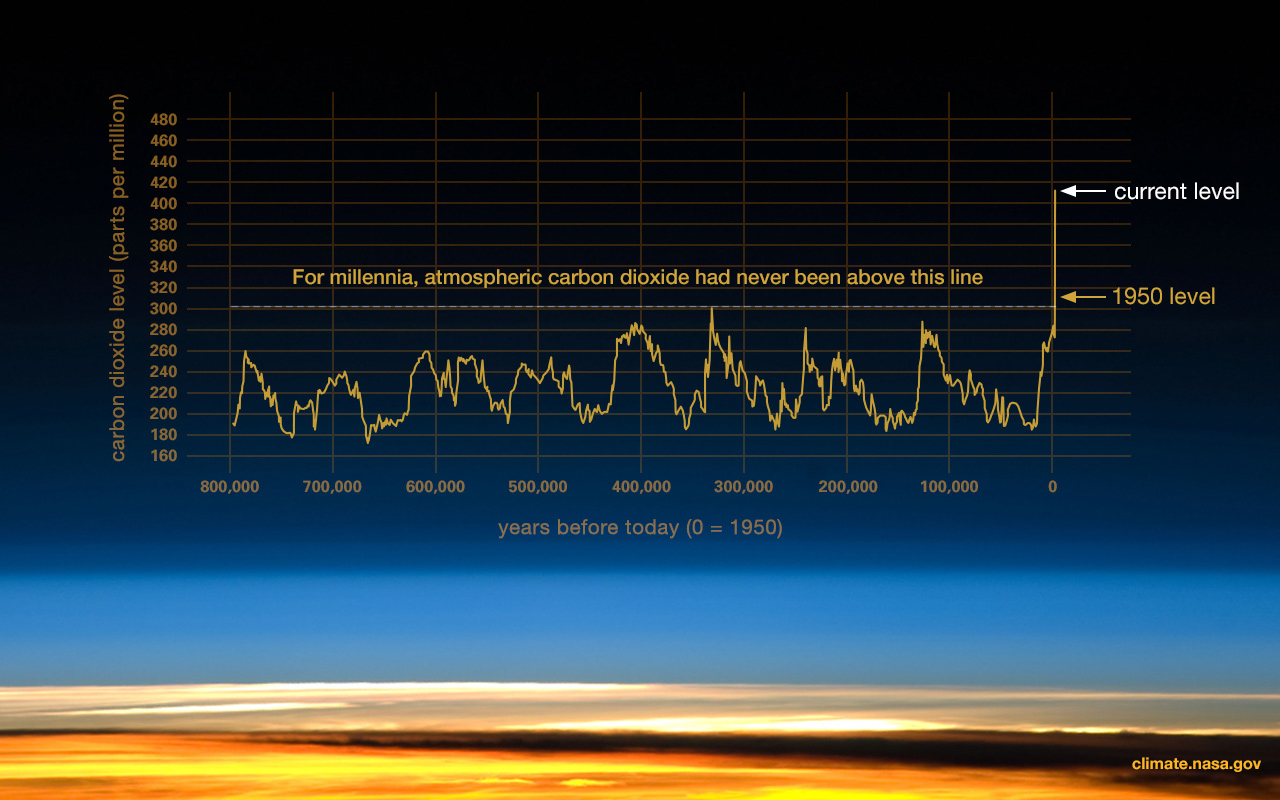
This graph, based on the comparison of atmospheric samples contained in ice cores and more recent direct measurements, provides evidence that atmospheric CO2 has increased since the Industrial Revolution. (Credit: Luthi, D., et al.. 2008; Etheridge, D.M., et al. 2010; Vostok ice core data/J.R. Petit et al.; NOAA Mauna Loa CO2 record.) Find out more about ice cores (external site).
The Earth's climate has changed throughout history. Just in the last 650,000 years there have been seven cycles of glacial advance and retreat, with the abrupt end of the last ice age about 7,000 years ago marking the beginning of the modern climate era — and of human civilization. Most of these climate changes are attributed to very small variations in Earth’s orbit that change the amount of solar energy our planet receives.
Earth-orbiting satellites and other technological advances have enabled scientists to see the big picture, collecting many different types of information about our planet and its climate on a global scale. This body of data, collected over many years, reveals the signals of a changing climate.
The heat-trapping nature of carbon dioxide and other gases was demonstrated in the mid-19th century.2 Their ability to affect the transfer of infrared energy through the atmosphere is the scientific basis of many instruments flown by NASA. There is no question that increased levels of greenhouse gases must cause the Earth to warm in response.
Ice cores drawn from Greenland, Antarctica, and tropical mountain glaciers show that the Earth’s climate responds to changes in greenhouse gas levels. Ancient evidence can also be found in tree rings, ocean sediments, coral reefs, and layers of sedimentary rocks. This ancient, or paleoclimate, evidence reveals that current warming is occurring roughly ten times faster than the average rate of ice-age-recovery warming.3
+ more
+ more
+ more
+ more
+ more
+ more
+ more
+ more
+ more
https://climate.nasa.gov/evidence/
[list=footnotes]
[*]IPCC Fifth Assessment Report, Summary for Policymakers
B.D. Santer et.al., “A search for human influences on the thermal structure of the atmosphere,” Nature vol 382, 4 July 1996, 39-46
Gabriele C. Hegerl, “Detecting Greenhouse-Gas-Induced Climate Change with an Optimal Fingerprint Method,” Journal of Climate, v. 9, October 1996, 2281-2306
V. Ramaswamy et.al., “Anthropogenic and Natural Influences in the Evolution of Lower Stratospheric Cooling,” Science 311 (24 February 2006), 1138-1141
B.D. Santer et.al., “Contributions of Anthropogenic and Natural Forcing to Recent Tropopause Height Changes,” Science vol. 301 (25 July 2003), 479-483.
[*]In the 1860s, physicist John Tyndall recognized the Earth's natural greenhouse effect and suggested that slight changes in the atmospheric composition could bring about climatic variations. In 1896, a seminal paper by Swedish scientist Svante Arrhenius first predicted that changes in the levels of carbon dioxide in the atmosphere could substantially alter the surface temperature through the greenhouse effect.
[*]National Research Council (NRC), 2006. Surface Temperature Reconstructions For the Last 2,000 Years. National Academy Press, Washington, D.C.
http://earthobservatory.nasa.gov/Features/GlobalWarming/page3.php
[*]https://www.ncdc.noaa.gov/monitoring-references/faq/indicators.php
http://www.cru.uea.ac.uk/cru/data/temperature
http://data.giss.nasa.gov/gistemp
[*]https://www.giss.nasa.gov/research/news/20170118/
[*]Levitus, S.; Antonov, J.; Boyer, T.; Baranova, O.; Garcia, H.; Locarnini, R.; Mishonov, A.; Reagan, J.; Seidov, D.; Yarosh, E.; Zweng, M. (2017). NCEI ocean heat content, temperature anomalies, salinity anomalies, thermosteric sea level anomalies, halosteric sea level anomalies, and total steric sea level anomalies from 1955 to present calculated from in situ oceanographic subsurface profile data (NCEI Accession 0164586). Version 4.4. NOAA National Centers for Environmental Information. Dataset. doi:10.7289/V53F4MVP
[*]https://www.jpl.nasa.gov/news/news.php?feature=7159
[*]National Snow and Ice Data Center
World Glacier Monitoring Service
[*]National Snow and Ice Data Center
Robinson, D. A., D. K. Hall, and T. L. Mote. 2014. MEaSUREs Northern Hemisphere Terrestrial Snow Cover Extent Daily 25km EASE-Grid 2.0, Version 1. [Indicate subset used]. Boulder, Colorado USA. NASA National Snow and Ice Data Center Distributed Active Archive Center. doi: https://doi.org/10.5067/MEASURES/CRYOSPHERE/nsidc-0530.001. [Accessed 9/21/18].
http://nsidc.org/cryosphere/sotc/snow_extent.html
Rutgers University Global Snow Lab, Data History Accessed September 21, 2018.
[*]R. S. Nerem, B. D. Beckley, J. T. Fasullo, B. D. Hamlington, D. Masters and G. T. Mitchum. Climate-change–driven accelerated sea-level rise detected in the altimeter era. PNAS, 2018 DOI: 10.1073/pnas.1717312115
[*]https://nsidc.org/cryosphere/sotc/sea_ice.html
[*]USGCRP, 2017: Climate Science Special Report: Fourth National Climate Assessment, Volume I [Wuebbles, D.J., D.W. Fahey, K.A. Hibbard, D.J. Dokken, B.C. Stewart, and T.K. Maycock (eds.)]. U.S. Global Change Research Program, Washington, DC, USA, 470 pp, doi: 10.7930/J0J964J6
[*]http://www.pmel.noaa.gov/co2/story/What+is+Ocean+Acidification%3F
[*]http://www.pmel.noaa.gov/co2/story/Ocean+Acidification
[*]C. L. Sabine et.al., “The Oceanic Sink for Anthropogenic CO2,” Science vol. 305 (16 July 2004), 367-371
[*]Copenhagen Diagnosis, p. 36.
[/list]

This graph, based on the comparison of atmospheric samples contained in ice cores and more recent direct measurements, provides evidence that atmospheric CO2 has increased since the Industrial Revolution. (Credit: Luthi, D., et al.. 2008; Etheridge, D.M., et al. 2010; Vostok ice core data/J.R. Petit et al.; NOAA Mauna Loa CO2 record.) Find out more about ice cores (external site).
The Earth's climate has changed throughout history. Just in the last 650,000 years there have been seven cycles of glacial advance and retreat, with the abrupt end of the last ice age about 7,000 years ago marking the beginning of the modern climate era — and of human civilization. Most of these climate changes are attributed to very small variations in Earth’s orbit that change the amount of solar energy our planet receives.
The current warming trend is of particular significance because most of it is extremely likely (greater than 95 percent probability) to be the result of human activity since the mid-20th century and proceeding at a rate that is unprecedented over decades to millennia.1
Scientific evidence for warming of the climate system is unequivocal.
- Intergovernmental Panel on Climate Change
Earth-orbiting satellites and other technological advances have enabled scientists to see the big picture, collecting many different types of information about our planet and its climate on a global scale. This body of data, collected over many years, reveals the signals of a changing climate.
The heat-trapping nature of carbon dioxide and other gases was demonstrated in the mid-19th century.2 Their ability to affect the transfer of infrared energy through the atmosphere is the scientific basis of many instruments flown by NASA. There is no question that increased levels of greenhouse gases must cause the Earth to warm in response.
Ice cores drawn from Greenland, Antarctica, and tropical mountain glaciers show that the Earth’s climate responds to changes in greenhouse gas levels. Ancient evidence can also be found in tree rings, ocean sediments, coral reefs, and layers of sedimentary rocks. This ancient, or paleoclimate, evidence reveals that current warming is occurring roughly ten times faster than the average rate of ice-age-recovery warming.3
The evidence for rapid climate change is compelling:
Global Temperature Rise
The planet's average surface temperature has risen about 1.62 degrees Fahrenheit (0.9 degrees Celsius) since the late 19th century, a change driven largely by increased carbon dioxide and other human-made emissions into the atmosphere.4 Most of the warming occurred in the past 35 years, with the five warmest years on record taking place since 2010. Not only was 2016 the warmest year on record, but eight of the 12 months that make up the year — from January through September, with the exception of June — were the warmest on record for those respective months. 5
+ more
Warming Oceans
The oceans have absorbed much of this increased heat, with the top 700 meters (about 2,300 feet) of ocean showing warming of more than 0.4 degrees Fahrenheit since 1969.6
+ more
Shrinking Ice Sheets
The Greenland and Antarctic ice sheets have decreased in mass. Data from NASA's Gravity Recovery and Climate Experiment show Greenland lost an average of 286 billion tons of ice per year between 1993 and 2016, while Antarctica lost about 127 billion tons of ice per year during the same time period. The rate of Antarctica ice mass loss has tripled in the last decade.7
Image: Flowing meltwater from the Greenland ice sheet
+ more
Glacial Retreat
Glaciers are retreating almost everywhere around the world — including in the Alps, Himalayas, Andes, Rockies, Alaska and Africa.8
Image: The disappearing snowcap of Mount Kilimanjaro, from space.
+ more
Decreased Snow Cover
Satellite observations reveal that the amount of spring snow cover in the Northern Hemisphere has decreased over the past five decades and that the snow is melting earlier.9
+ more
Sea Level Rise
Global sea level rose about 8 inches in the last century. The rate in the last two decades, however, is nearly double that of the last century and is accelerating slightly every year.10
Image: Republic of Maldives: Vulnerable to sea level rise
+ more
Declining Arctic Sea Ice
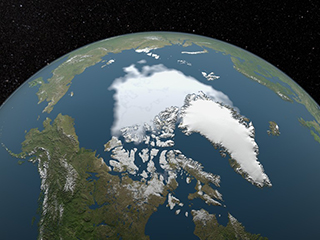
Both the extent and thickness of Arctic sea ice has declined rapidly over the last several decades.11
Image: Visualization of the 2012 Arctic sea ice minimum, the lowest on record
+ more
Extreme Events
The number of record high temperature events in the United States has been increasing, while the number of record low temperature events has been decreasing, since 1950. The U.S. has also witnessed increasing numbers of intense rainfall events.12
+ more
Ocean Acidification
Since the beginning of the Industrial Revolution, the acidity of surface ocean waters has increased by about 30 percent.13,14 This increase is the result of humans emitting more carbon dioxide into the atmosphere and hence more being absorbed into the oceans. The amount of carbon dioxide absorbed by the upper layer of the oceans is increasing by about 2 billion tons per year.15,16
+ more
https://climate.nasa.gov/evidence/
References
[list=footnotes]
[*]IPCC Fifth Assessment Report, Summary for Policymakers
B.D. Santer et.al., “A search for human influences on the thermal structure of the atmosphere,” Nature vol 382, 4 July 1996, 39-46
Gabriele C. Hegerl, “Detecting Greenhouse-Gas-Induced Climate Change with an Optimal Fingerprint Method,” Journal of Climate, v. 9, October 1996, 2281-2306
V. Ramaswamy et.al., “Anthropogenic and Natural Influences in the Evolution of Lower Stratospheric Cooling,” Science 311 (24 February 2006), 1138-1141
B.D. Santer et.al., “Contributions of Anthropogenic and Natural Forcing to Recent Tropopause Height Changes,” Science vol. 301 (25 July 2003), 479-483.
[*]In the 1860s, physicist John Tyndall recognized the Earth's natural greenhouse effect and suggested that slight changes in the atmospheric composition could bring about climatic variations. In 1896, a seminal paper by Swedish scientist Svante Arrhenius first predicted that changes in the levels of carbon dioxide in the atmosphere could substantially alter the surface temperature through the greenhouse effect.
[*]National Research Council (NRC), 2006. Surface Temperature Reconstructions For the Last 2,000 Years. National Academy Press, Washington, D.C.
http://earthobservatory.nasa.gov/Features/GlobalWarming/page3.php
[*]https://www.ncdc.noaa.gov/monitoring-references/faq/indicators.php
http://www.cru.uea.ac.uk/cru/data/temperature
http://data.giss.nasa.gov/gistemp
[*]https://www.giss.nasa.gov/research/news/20170118/
[*]Levitus, S.; Antonov, J.; Boyer, T.; Baranova, O.; Garcia, H.; Locarnini, R.; Mishonov, A.; Reagan, J.; Seidov, D.; Yarosh, E.; Zweng, M. (2017). NCEI ocean heat content, temperature anomalies, salinity anomalies, thermosteric sea level anomalies, halosteric sea level anomalies, and total steric sea level anomalies from 1955 to present calculated from in situ oceanographic subsurface profile data (NCEI Accession 0164586). Version 4.4. NOAA National Centers for Environmental Information. Dataset. doi:10.7289/V53F4MVP
[*]https://www.jpl.nasa.gov/news/news.php?feature=7159
[*]National Snow and Ice Data Center
World Glacier Monitoring Service
[*]National Snow and Ice Data Center
Robinson, D. A., D. K. Hall, and T. L. Mote. 2014. MEaSUREs Northern Hemisphere Terrestrial Snow Cover Extent Daily 25km EASE-Grid 2.0, Version 1. [Indicate subset used]. Boulder, Colorado USA. NASA National Snow and Ice Data Center Distributed Active Archive Center. doi: https://doi.org/10.5067/MEASURES/CRYOSPHERE/nsidc-0530.001. [Accessed 9/21/18].
http://nsidc.org/cryosphere/sotc/snow_extent.html
Rutgers University Global Snow Lab, Data History Accessed September 21, 2018.
[*]R. S. Nerem, B. D. Beckley, J. T. Fasullo, B. D. Hamlington, D. Masters and G. T. Mitchum. Climate-change–driven accelerated sea-level rise detected in the altimeter era. PNAS, 2018 DOI: 10.1073/pnas.1717312115
[*]https://nsidc.org/cryosphere/sotc/sea_ice.html
[*]USGCRP, 2017: Climate Science Special Report: Fourth National Climate Assessment, Volume I [Wuebbles, D.J., D.W. Fahey, K.A. Hibbard, D.J. Dokken, B.C. Stewart, and T.K. Maycock (eds.)]. U.S. Global Change Research Program, Washington, DC, USA, 470 pp, doi: 10.7930/J0J964J6
[*]http://www.pmel.noaa.gov/co2/story/What+is+Ocean+Acidification%3F
[*]http://www.pmel.noaa.gov/co2/story/Ocean+Acidification
[*]C. L. Sabine et.al., “The Oceanic Sink for Anthropogenic CO2,” Science vol. 305 (16 July 2004), 367-371
[*]Copenhagen Diagnosis, p. 36.
[/list]

melkior- Posts : 17503
2015-08-09
 Re: Trump prošao pokraj buduće nobelovke za mir kao pokraj turskog groblja
Re: Trump prošao pokraj buduće nobelovke za mir kao pokraj turskog groblja
_________________
It was always the women, and above all the young ones, who were the most bigotet adherents of the party, the swallowers of slogans, the amateur spies and nosers-out of unortodoxy.
Orwell 1984

prckov- Posts : 34555
2014-04-19
 Re: Trump prošao pokraj buduće nobelovke za mir kao pokraj turskog groblja
Re: Trump prošao pokraj buduće nobelovke za mir kao pokraj turskog groblja
ajmo zamisliti svijet "sukladan" ovim žabama zelenjačama.
eto, imamo urbane pravovjernike. ajmo srušit nasipe od samobora pa do broda. uz savu.
kada počnu kišurine javiti slovencima neka prestanu kontrolirati protok save i neka ju puste.
jebem vas, internet, ravnu ploču i co2
ubijte se i manje co2.
bacite plastiku iz kuće, stana. odjebite fosilna goriva. ne lovite živine i napokon krepajte.
eto, imamo urbane pravovjernike. ajmo srušit nasipe od samobora pa do broda. uz savu.
kada počnu kišurine javiti slovencima neka prestanu kontrolirati protok save i neka ju puste.
jebem vas, internet, ravnu ploču i co2
ubijte se i manje co2.
bacite plastiku iz kuće, stana. odjebite fosilna goriva. ne lovite živine i napokon krepajte.
_________________
AfD

veber-

Posts : 53509
2014-12-30
 Re: Trump prošao pokraj buduće nobelovke za mir kao pokraj turskog groblja
Re: Trump prošao pokraj buduće nobelovke za mir kao pokraj turskog groblja
ne smarajmelkior wrote:Climate Change: How Do We Know?
sta ti je


prckov- Posts : 34555
2014-04-19
 Re: Trump prošao pokraj buduće nobelovke za mir kao pokraj turskog groblja
Re: Trump prošao pokraj buduće nobelovke za mir kao pokraj turskog groblja
melkior wrote:Climate Change: How Do We Know?
This graph, based on the comparison of atmospheric samples contained in ice cores and more recent direct measurements, provides evidence that atmospheric CO2 has increased since the Industrial Revolution. (Credit: Luthi, D., et al.. 2008; Etheridge, D.M., et al. 2010; Vostok ice core data/J.R. Petit et al.; NOAA Mauna Loa CO2 record.) Find out more about ice cores (external site).
The Earth's climate has changed throughout history. Just in the last 650,000 years there have been seven cycles of glacial advance and retreat, with the abrupt end of the last ice age about 7,000 years ago marking the beginning of the modern climate era — and of human civilization. Most of these climate changes are attributed to very small variations in Earth’s orbit that change the amount of solar energy our planet receives.The current warming trend is of particular significance because most of it is extremely likely (greater than 95 percent probability) to be the result of human activity since the mid-20th century and proceeding at a rate that is unprecedented over decades to millennia.1
Scientific evidence for warming of the climate system is unequivocal.
- Intergovernmental Panel on Climate Change
Earth-orbiting satellites and other technological advances have enabled scientists to see the big picture, collecting many different types of information about our planet and its climate on a global scale. This body of data, collected over many years, reveals the signals of a changing climate.
The heat-trapping nature of carbon dioxide and other gases was demonstrated in the mid-19th century.2 Their ability to affect the transfer of infrared energy through the atmosphere is the scientific basis of many instruments flown by NASA. There is no question that increased levels of greenhouse gases must cause the Earth to warm in response.
Ice cores drawn from Greenland, Antarctica, and tropical mountain glaciers show that the Earth’s climate responds to changes in greenhouse gas levels. Ancient evidence can also be found in tree rings, ocean sediments, coral reefs, and layers of sedimentary rocks. This ancient, or paleoclimate, evidence reveals that current warming is occurring roughly ten times faster than the average rate of ice-age-recovery warming.3The evidence for rapid climate change is compelling:
Global Temperature Rise
The planet's average surface temperature has risen about 1.62 degrees Fahrenheit (0.9 degrees Celsius) since the late 19th century, a change driven largely by increased carbon dioxide and other human-made emissions into the atmosphere.4 Most of the warming occurred in the past 35 years, with the five warmest years on record taking place since 2010. Not only was 2016 the warmest year on record, but eight of the 12 months that make up the year — from January through September, with the exception of June — were the warmest on record for those respective months. 5
+ moreWarming Oceans
The oceans have absorbed much of this increased heat, with the top 700 meters (about 2,300 feet) of ocean showing warming of more than 0.4 degrees Fahrenheit since 1969.6
+ moreShrinking Ice Sheets
The Greenland and Antarctic ice sheets have decreased in mass. Data from NASA's Gravity Recovery and Climate Experiment show Greenland lost an average of 286 billion tons of ice per year between 1993 and 2016, while Antarctica lost about 127 billion tons of ice per year during the same time period. The rate of Antarctica ice mass loss has tripled in the last decade.7
Image: Flowing meltwater from the Greenland ice sheet
+ moreGlacial Retreat
Glaciers are retreating almost everywhere around the world — including in the Alps, Himalayas, Andes, Rockies, Alaska and Africa.8
Image: The disappearing snowcap of Mount Kilimanjaro, from space.
+ moreDecreased Snow Cover
Satellite observations reveal that the amount of spring snow cover in the Northern Hemisphere has decreased over the past five decades and that the snow is melting earlier.9
+ moreSea Level Rise
Global sea level rose about 8 inches in the last century. The rate in the last two decades, however, is nearly double that of the last century and is accelerating slightly every year.10
Image: Republic of Maldives: Vulnerable to sea level rise
+ moreDeclining Arctic Sea Ice
Both the extent and thickness of Arctic sea ice has declined rapidly over the last several decades.11
Image: Visualization of the 2012 Arctic sea ice minimum, the lowest on record
+ moreExtreme Events
The number of record high temperature events in the United States has been increasing, while the number of record low temperature events has been decreasing, since 1950. The U.S. has also witnessed increasing numbers of intense rainfall events.12
+ moreOcean Acidification
Since the beginning of the Industrial Revolution, the acidity of surface ocean waters has increased by about 30 percent.13,14 This increase is the result of humans emitting more carbon dioxide into the atmosphere and hence more being absorbed into the oceans. The amount of carbon dioxide absorbed by the upper layer of the oceans is increasing by about 2 billion tons per year.15,16
+ more
https://climate.nasa.gov/evidence/References
The Causes of Climate Change

A simplified animation of the greenhouse effect. Credit: NASA/JPL-Caltech
Scientists attribute the global warming trend observed since the mid-20th century to the human expansion of the "greenhouse effect"1 — warming that results when the atmosphere traps heat radiating from Earth toward space.
Certain gases in the atmosphere block heat from escaping. Long-lived gases that remain semi-permanently in the atmosphere and do not respond physically or chemically to changes in temperature are described as "forcing" climate change. Gases, such as water vapor, which respond physically or chemically to changes in temperature are seen as "feedbacks."
Gases that contribute to the greenhouse effect include:
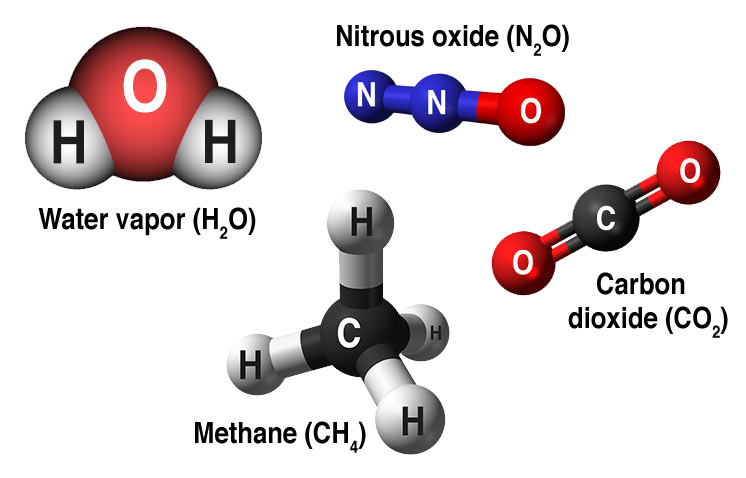
- Water vapor. The most abundant greenhouse gas, but importantly, it acts as a feedback to the climate. Water vapor increases as the Earth's atmosphere warms, but so does the possibility of clouds and precipitation, making these some of the most important feedback mechanisms to the greenhouse effect.
- Carbon dioxide (CO2). A minor but very important component of the atmosphere, carbon dioxide is released through natural processes such as respiration and volcano eruptions and through human activities such as deforestation, land use changes, and burning fossil fuels. Humans have increased atmospheric CO2 concentration by more than a third since the Industrial Revolution began. This is the most important long-lived "forcing" of climate change.
- Methane. A hydrocarbon gas produced both through natural sources and human activities, including the decomposition of wastes in landfills, agriculture, and especially rice cultivation, as well as ruminant digestion and manure management associated with domestic livestock. On a molecule-for-molecule basis, methane is a far more active greenhouse gas than carbon dioxide, but also one which is much less abundant in the atmosphere.
- Nitrous oxide. A powerful greenhouse gas produced by soil cultivation practices, especially the use of commercial and organic fertilizers, fossil fuel combustion, nitric acid production, and biomass burning.
- Chlorofluorocarbons (CFCs). Synthetic compounds entirely of industrial origin used in a number of applications, but now largely regulated in production and release to the atmosphere by international agreement for their ability to contribute to destruction of the ozone layer. They are also greenhouse gases.
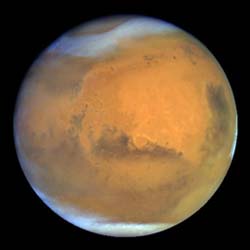 Not enough greenhouse effect: The planet Mars has a very thin atmosphere, nearly all carbon dioxide. Because of the low atmospheric pressure, and with little to no methane or water vapor to reinforce the weak greenhouse effect, Mars has a largely frozen surface that shows no evidence of life.
Not enough greenhouse effect: The planet Mars has a very thin atmosphere, nearly all carbon dioxide. Because of the low atmospheric pressure, and with little to no methane or water vapor to reinforce the weak greenhouse effect, Mars has a largely frozen surface that shows no evidence of life.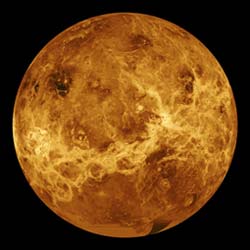 Too much greenhouse effect: The atmosphere of Venus, like Mars, is nearly all carbon dioxide. But Venus has about 154,000 times as much carbon dioxide in its atmosphere as Earth (and about 19,000 times as much as Mars does), producing a runaway greenhouse effect and a surface temperature hot enough to melt lead.
Too much greenhouse effect: The atmosphere of Venus, like Mars, is nearly all carbon dioxide. But Venus has about 154,000 times as much carbon dioxide in its atmosphere as Earth (and about 19,000 times as much as Mars does), producing a runaway greenhouse effect and a surface temperature hot enough to melt lead.On Earth, human activities are changing the natural greenhouse. Over the last century the burning of fossil fuels like coal and oil has increased the concentration of atmospheric carbon dioxide (CO2). This happens because the coal or oil burning process combines carbon with oxygen in the air to make CO2. To a lesser extent, the clearing of land for agriculture, industry, and other human activities has increased concentrations of greenhouse gases.
The consequences of changing the natural atmospheric greenhouse are difficult to predict, but certain effects seem likely:
- On average, Earth will become warmer. Some regions may welcome warmer temperatures, but others may not.
- Warmer conditions will probably lead to more evaporation and precipitation overall, but individual regions will vary, some becoming wetter and others dryer.
- A stronger greenhouse effect will warm the oceans and partially melt glaciers and other ice, increasing sea level. Ocean water also will expand if it warms, contributing further to sea level rise.
- Meanwhile, some crops and other plants may respond favorably to increased atmospheric CO2, growing more vigorously and using water more efficiently. At the same time, higher temperatures and shifting climate patterns may change the areas where crops grow best and affect the makeup of natural plant communities.
The Role of Human Activity
In its Fifth Assessment Report, the Intergovernmental Panel on Climate Change, a group of 1,300 independent scientific experts from countries all over the world under the auspices of the United Nations, concluded there's a more than 95 percent probability that human activities over the past 50 years have warmed our planet.
The industrial activities that our modern civilization depends upon have raised atmospheric carbon dioxide levels from 280 parts per million to 400 parts per million in the last 150 years. The panel also concluded there's a better than 95 percent probability that human-produced greenhouse gases such as carbon dioxide, methane and nitrous oxide have caused much of the observed increase in Earth's temperatures over the past 50 years.
The panel's full Summary for Policymakers report is online at https://www.ipcc.ch/site/assets/uploads/2018/02/ipcc_wg3_ar5_summary-for-policymakers.pdf.
Solar Irradiance
The amount of solar energy that Earth receives has followed the Sun’s natural 11-year cycle of small ups and downs with no net increase since the 1950s. Over the same period, global temperature has risen markedly. It is therefore extremely unlikely that the Sun has caused the observed global temperature warming trend over the past half-century. Credit: NASA/JPL-Caltech
It's reasonable to assume that changes in the Sun's energy output would cause the climate to change, since the Sun is the fundamental source of energy that drives our climate system.
Indeed, studies show that solar variability has played a role in past climate changes. For example, a decrease in solar activity coupled with an increase in volcanic activity is thought to have helped trigger the Little Ice Age between approximately 1650 and 1850, when Greenland cooled from 1410 to the 1720s and glaciers advanced in the Alps.
But several lines of evidence show that current global warming cannot be explained by changes in energy from the Sun:
- Since 1750, the average amount of energy coming from the Sun either remained constant or increased slightly.
- If the warming were caused by a more active Sun, then scientists would expect to see warmer temperatures in all layers of the atmosphere. Instead, they have observed a cooling in the upper atmosphere, and a warming at the surface and in the lower parts of the atmosphere. That's because greenhouse gases are trapping heat in the lower atmosphere.
- Climate models that include solar irradiance changes can’t reproduce the observed temperature trend over the past century or more without including a rise in greenhouse gases.
https://climate.nasa.gov/causes/
References
[list=footnotes][*]IPCC Fifth Assessment Report, 2014
United States Global Change Research Program, "Global Climate Change Impacts in the United States," Cambridge University Press, 2009
Naomi Oreskes, "The Scientific Consensus on Climate Change," Science 3 December 2004: Vol. 306 no. 5702 p. 1686 DOI: 10.1126/science.1103618
[*]
Mike Lockwood, “Solar Change and Climate: an update in the light of the current exceptional solar minimum,” Proceedings of the Royal Society A, 2 December 2009, doi 10.1098/rspa.2009.0519;
Judith Lean, “Cycles and trends in solar irradiance and climate,” Wiley
[/list]

melkior- Posts : 17503
2015-08-09
 Re: Trump prošao pokraj buduće nobelovke za mir kao pokraj turskog groblja
Re: Trump prošao pokraj buduće nobelovke za mir kao pokraj turskog groblja
melkior wrote:Emančipiranu ju izignorirao Trump. Arhetipski neprijatelji se susreli na brvnu. Makar, žao mi je klinke, ona barem ima ideale.RayMabus wrote:
Baš je simpa.
Ma Trump je nije niti vidio ... ova je bila u kutu popunjenog hodnika na jedino 10 metara udaljenost

Hektorović- Posts : 26373
2018-04-10
Page 8 of 12 •  1, 2, 3 ... 7, 8, 9, 10, 11, 12
1, 2, 3 ... 7, 8, 9, 10, 11, 12 
 Similar topics
Similar topics» Književnost s groblja...
» Kad pokraj bauštele vikneš: “Zemljače!”, svi se okreću
» Pokraj Zagreba proizvodit će se dijelovi za Boing,Airbus
» Nobelovke posjetile kamp u Brodu: 'Ne smijemo dopustiti da se napad u Parizu iskoristi za poticanje ksenofobije'
» Rusi i u Uljaniku, VTB će pratiti buduće vlasnike
» Kad pokraj bauštele vikneš: “Zemljače!”, svi se okreću
» Pokraj Zagreba proizvodit će se dijelovi za Boing,Airbus
» Nobelovke posjetile kamp u Brodu: 'Ne smijemo dopustiti da se napad u Parizu iskoristi za poticanje ksenofobije'
» Rusi i u Uljaniku, VTB će pratiti buduće vlasnike
Page 8 of 12
Permissions in this forum:
You cannot reply to topics in this forum
 Events
Events Latest images
Latest images
 by melkior 24/9/2019, 23:24
by melkior 24/9/2019, 23:24






